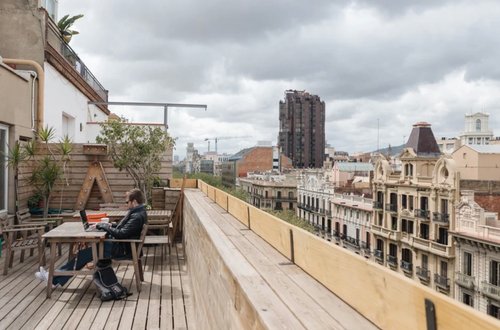How the pandemic is driving a virtual tech boom
08 juin 2021
5min


It started with the Sims and continued with Second Life. These games that simulate real-life opened the way to an alternative reality in which our virtual existence could be comparable to our real one. They gave us a vision of how we could interact on a non-physical plane with anyone, regardless of where they were around the world. Today a large percentage of people on the planet have inexpensive smartphones that are more powerful than hulking computers were just a few years ago, which highlights the huge advances that have been made. So are these virtual worlds, which are driven by technological advances, the future of work?
If you have not yet read Ernest Cline’s Ready Player One or Cixin Liu’s The Three Body Problem trilogy, you are not only missing out on two of the best science fiction books of the past decade, but also on gaining insight into how humankind’s digital interactions are going to change definitively after the pandemic. Today, as happened after the publication of Ender’s Game many years ago, situations that we see as somewhat far-fetched will soon be part of our daily lives. In Orson Scott Card’s novel, it was envisioned that the internet and tablets would take about 20 years to become a reality, but in those of Cline and Liu, the future is much closer.
A group of tech companies led by Sony has just given Epic Games, the maker of Fortnite and People can Fly, more than $1 billion to create a “metaverse”: a mixture of virtual and augmented reality that would replace the internet as we know it and where humans could interact without physical or monetary limits. Alternative economies to the official ones are already being established in the cloud, as demonstrated by the Coinbase flotation a few weeks ago. But how realistic are these plans?
The world of work is moving towards a hybrid model where some days are spent in an office and some at home, even as tasks are redefined. Digital connections between colleagues, clients, suppliers, and others will be key to this. The underlying questions are: How will the technology evolve to give us optimal use? What will be the timeline of that evolution?
Virtual communication: a new generation of platforms
Zoom, the company whose technology gave rise to one of the ills of teleworking (Zoom fatigue), is leading the creation of a €100 million fund to invest in start-ups that create tools to complement its software. The company’s plan is to move towards a future in which the user experience goes beyond simple multi-share screen video calls, but without the user having to leave the environment they created and with which millions of people around the world became familiar in the past year.
The struggle to dominate virtual communications will represent one of the great bets of the leading companies in the software environment in the coming years. This was demonstrated in February 2021 with the launch of Viva by Microsoft, a platform that brings together communications, knowledge, learning, resources, and information for the employees of any company, and that is aiming to achieve more global functionalities focused on improving productivity and workers’ wellbeing. There are many points of connection at which they intend to generate interactions––and collect data. The platform includes programs to promote relaxation, integrated “gamification” of positive reinforcement for tasks performed, and the collection of “Big Data” on performance, which is returned to managers or supervisors.
The struggle to dominate virtual communications will represent one of the great bets of the leading companies in the software environment in the coming years.
Webex, the videoconferencing arm of American giant Cisco, has created a similar technology. Its People Insight is dedicated to monitoring the activities of staff working remotely alongside those in offices. What both companies share is a concern, they say, for the privacy of employees. They aspire to create digital reports that will help users to understand which type of people work best together or when to optimize group meetings.
However, these advances are framed within what we could call “common windows” and happen with a direct connection to a computer, tablet, or smartphone. But they are still far from how we imagine our long-distance relationships could be, though some companies have had success envisioning and trying out alternatives already.
Online universes: from games to daily tasks
Gustavo Medina del Rosario was born in the Canary Islands but operates the Singular Factory, an IT company, from Florida with a team spread across more than 10 countries and various time zones. The need to manage this situation, where all workers are fully remote, led to the creation of a program that is used by thousands: Nubii. Now he has taken the first step towards creating a space that, despite being completely virtual, maintains the feeling of being in the same physical environment.
Nubii recalls the way we used to connect in The Sims or Second Life: it could be described as a screen where each member of the team has their own avatar. Once configured, you can access the office, which can be designed to look just like your real one. You can choose a place to “sit”. You can access a meeting room with other colleagues, have a virtual coffee with them and even decide to spend 10 minutes in the corridors to have a chat. To avoid unnecessary interruptions when you are working, you can choose a color to indicate whether you are available or not. So, for example, green means you are free, yellow means you can take a call, and red means “do not disturb”.
You can choose a place to “sit”. You can access a meeting room with other colleagues, have a virtual coffee with them and even decide to spend 10 minutes in the corridors to have a chat.
“The pandemic has accelerated a trend that has not only multiplied the speed of implementation by 10, but has also shown that this situation is here to stay,” said Medina del Rosario. Some companies are offering staff the option to return to the office or to work from home full-time so as to attract the best talent, he added. That can be difficult for smaller companies. “This poses a problem for companies like ours, which are not multinationals, and which are encountering increased difficulty in attracting good people,” he said, adding that offering the option to work from home is how his company manages to consistently recruit the best candidates.
Short-term immersive experiences: reality or utopia?
In the era of screens and teleworking, our imaginations–– and even some experts––look to immersive experiences, virtual and augmented reality, and even holograms like those that George Lucas used in the original Star Wars with Obi Wan Kenobi.
Some experts look to immersive experiences, virtual and augmented reality, and even holograms.
Quasar Dynamics has been providing a service using this type of technology for some years to companies around the world. Even so, its chief executive Javier Ortizà does not get carried away talking about the possibilities, but he does leave the door open to intermediate options, such as the “mixed reality” projects in which they have collaborated with Microsoft, which makes Hololens smart glasses. “We have carried out mixed reality projects with Hololens, which involve the use of augmented reality at eye level. By leaving the user’s hands-free, the perception directly changes. There are already telecare services where the camera focuses on what the connected person is seeing and you can even make annotations that appear superimposed,” said Ortizà.
A great leap could be achieved if this type of device were adopted for leisure use in private homes by the large numbers of people and was later incorporated into the professional sphere. “Immersive reality, for example, needs a mobile phone and a camera, but options like Oculus (a virtual reality headset) already solves the problem. The price, which today is already lower than that of a high-end smartphone, will continue to fall. And maybe some companies will try to look for interactions through these devices,” he said.
Although we will be able to hold meetings with holograms, there is no substitute for the real thing, he said. “In my opinion there is no real-time technology to give the feeling that you are physically in another place. I have had test encounters and they have not been satisfactory, so I doubt that its application can be implemented immediately,” he said.
The technology we have today may just be a taste of what is to come, according to Ortizà. “Suddenly a disruption is created and everything changes, as we saw during the lockdown. Let’s not limit what comes to the two technologies that we know,” he said.
Translated By: Sunita Maharaj-Landaeta
Photo: Welcome to the Jungle
Follow Welcome to the Jungle on Facebook, LinkedIn, and Instagram, and subscribe to our newsletter to get our latest articles every day!

Inspirez-vous davantage sur : David Blay
Journaliste. Consultant et formateur en télétravail.

Can Moneyball help inspire a new era for human resources?
Let’s begin with two rather unusual starting points for these types of articles, both linked to the world of sport...
18 janv. 2024

Stop buying and start living lightly – and remotely
It's no secret that the younger generation lacks the financial security that their parents enjoyed, so how can they adapt?
19 oct. 2023

Is remote work the start of a new class struggle?
Flexible work is becoming an essential job perk, but where does that leave all the essential workers?
05 juil. 2023

Are you too anxious to be a digital nomad?
Working from the peace and quiet of a Californian beach town may sound like just the change you need, but does it work for everyone?
08 nov. 2022

WFH works—until you need to take time off
Studies have shown that people working from home have a tendency to prolong their working day. We feel guilty for “abandoning” our tasks...
29 mars 2022
La newsletter qui fait le taf
Envie de ne louper aucun de nos articles ? Une fois par semaine, des histoires, des jobs et des conseils dans votre boite mail.

Vous êtes à la recherche d’une nouvelle opportunité ?
Plus de 200 000 candidats ont trouvé un emploi sur Welcome to the Jungle.
Explorer les jobs